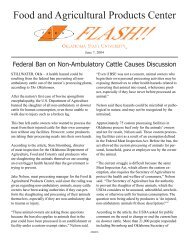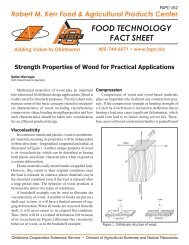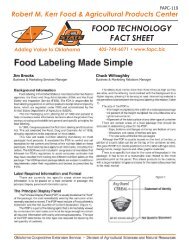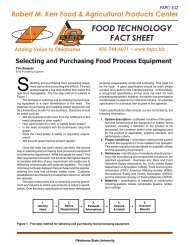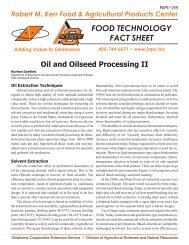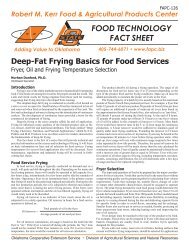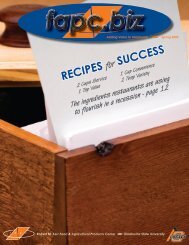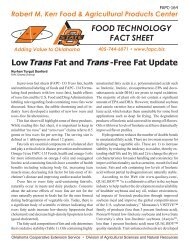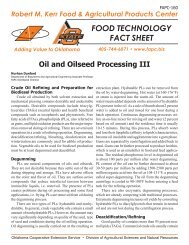Spring/Summer 2010 - Robert M. Kerr Food & Agricultural Products ...
Spring/Summer 2010 - Robert M. Kerr Food & Agricultural Products ...
Spring/Summer 2010 - Robert M. Kerr Food & Agricultural Products ...
You also want an ePaper? Increase the reach of your titles
YUMPU automatically turns print PDFs into web optimized ePapers that Google loves.
ne of the<br />
biggest<br />
food-related<br />
national news stories<br />
in 2009 has been the<br />
massive peanut recall.<br />
<strong>Products</strong> from<br />
raw peanuts to ice<br />
cream, and cookie<br />
mixes containing<br />
the contaminated nuts have<br />
been recalled for safety and<br />
health measures. Pistachio nuts<br />
also have been recalled for the same<br />
contamination found in the peanuts.<br />
A question remains in some<br />
American’s minds, how exactly did<br />
an in-plant mishap like this become<br />
such a national issue?<br />
The base of this question<br />
goes back to quality control<br />
actions taken at the plant<br />
level, how in-depth the inspection<br />
and control procedures at the<br />
plant are taken, and how seriously<br />
the quality control personnel take<br />
their jobs.<br />
According to Merriam-<br />
Webster, quality control is<br />
defined as “an aggregate<br />
of activities<br />
(as design analysis<br />
& inspection<br />
for defects)<br />
designed to ensure<br />
adequate quality<br />
especially in manufacturing<br />
products”<br />
(2009). Simply<br />
meaning, a process<br />
of checks<br />
and balances are<br />
6 | fapc.biz<br />
news<br />
By Kim Angstadt<br />
<strong>Food</strong> Science Undergraduate Student<br />
kim.angstadt@okstate.edu<br />
2009 Peanut Recall<br />
Could it have been avoided?<br />
The following paper by Kim Angstadt placed second in the FAPC Undergraduate Technical<br />
Writing Competition. For more information, visit www.fapc.biz/papercompetition.<br />
taken at the plant level to make sure<br />
the products being sold to the public<br />
to consume are safe to eat. Based on<br />
the definition, any peanut product that<br />
was properly tested and found positive<br />
to the Salmonella typhimurium<br />
never should have been released from<br />
the plant for further processing. Yet,<br />
the positively tested S. typhimurium<br />
product was released from a plant in<br />
Georgia, and a nation-wide recall was<br />
born (MSNBC, February 2009).<br />
Obviously, someone was not properly<br />
doing his or her job in Blakely,<br />
Georgia, or the tainted peanuts never<br />
would have been released from the<br />
plant. It brings the question of how<br />
efficient quality control technicians<br />
are at their jobs and how closely they<br />
pay attention to detail and variances<br />
in readings they get from tests performed,<br />
as well as, if some pertinent<br />
tests were even performed at all.<br />
There were initial reports of rats<br />
found in the plant the contaminated<br />
peanuts were from, and the source of<br />
contamination could have come from<br />
their interaction with the product.<br />
While the sights of rats or other pests<br />
or any kind of infestation was not evident<br />
(ABC, February 2009), that’s not<br />
to say the pests were not there. It also<br />
was apparent positive tests were found<br />
on the peanuts, but no one was prop-<br />
erly notified of them (ABC, February<br />
2009).<br />
Situations such as pests or positive<br />
readings on bacteriological tests<br />
performed by the quality control<br />
personnel at a plant should be signs,<br />
which action needs to be taken to<br />
prevent or control the problems. With<br />
this being said, it is evident the quality<br />
control personnel in this Blakely<br />
plant could have done a much better<br />
job at preventing contaminated product<br />
from leaving their plant. Thanks to<br />
their negligence, and responsibility to<br />
their company, Peanut Corporation of<br />
America has filed for bankruptcy because<br />
of the massive recall and tarnish<br />
to the peanut industry (FDA, 2009).<br />
Unfortunately, this is not the only<br />
recall issued during the past few years,<br />
but it is the most recent to hit home<br />
with a lot of people. What exactly is it<br />
going to take to make some companies<br />
and employees see that quality control,<br />
what they do in their plant and how<br />
efficient they are at testing and control<br />
of product, is a big deal and could potentially<br />
save lives?<br />
If supervisors take more enforcement<br />
at the plant, and quality control<br />
personnel report more of their findings,<br />
as well as take more care and<br />
efficiency in their testing, perhaps recalls<br />
in the future can be prevented.<br />
References:<br />
ABC. “Lawmakers Examine Peanut Recall.<br />
. 21 April 2009.<br />
MSNBC. “Cracking The Poison Processed Peanuts Case.”<br />
. 21 April 2009.<br />
USDS, <strong>Food</strong> & Drug Administration.<br />
. 20 April 2009.



